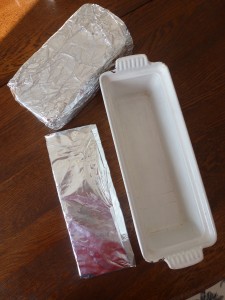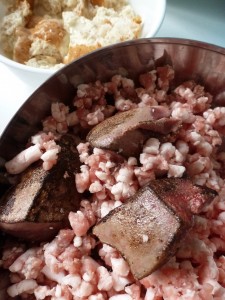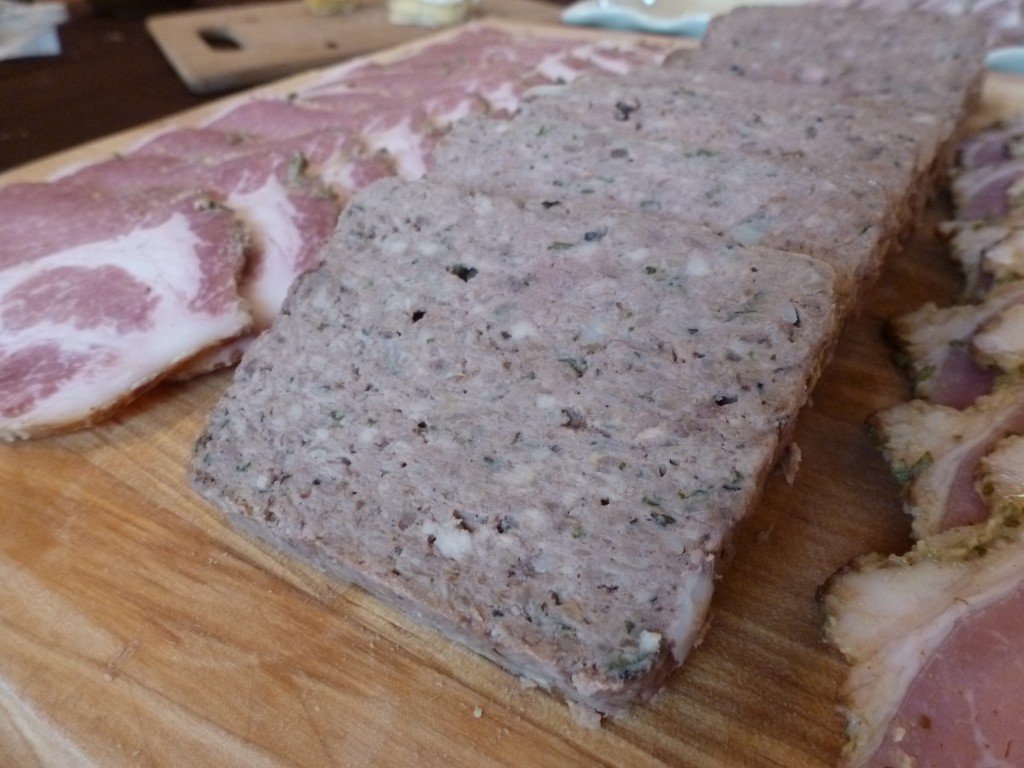“What the hell is pâté?”
Pâté is fancy French meatloaf: it’s ground meat, bound with dairy, eggs, and bread. The only difference is that pâté usually contains some liver, and it’s usually eaten cold. If it’s baked in a special ceramic dish, it can be called a terrine.
Within that definition, there is a spectrum of pâtés that runs from rustic to refined. The two qualities that decide a pâté’s place on the spectrum are texture and ingredients. Rustic pâtés are coarser in texture and made with cheaper, heartier ingredients, like liver. They are often described by words like campagne (“country”), grandmère (“grandma”), and maison (“house”). Refined pâtés have a finer, creamier texture and feature meat more prominently than liver. They may also have fancy interior garnishes, like foie gras or pistachio nuts. The following pâté is on the far rustic end of that spectrum, as it is coarsely ground and is half liver, half pork shoulder.
If you’re hesitant to work with liver, this is the dish for you. You still get a clear idea of what liver tastes like, but it is somewhat tempered. The slightly grainy, pasty texture is smoothed out by the presence of pork fat. This dish is your gateway to liver enjoyment.

Special equipment. Besides having some way to grind the meat and liver, the only special equipment required is a baking vessel. I use a traditional a terrine. You can make a terrine out of any cooking vessel, but the heavy, ceramic versions are best because they retain and evenly distribute heat.
Pâté has a delicate, almost spreadable texture. There is a bit of egg, a bit of bread, and a brief mixing period, but the majority of the binding is going to be done by weighing down the pâté after baking. For this I use a 2 kg brick wrapped in tin foil, and a piece of cardboard, roughly the size of the terrine, also wrapped in foil, to evenly distribute the weight of the brick.
Some things to keep in mind. For the best texture, we want to absolutely minimize leaching fat. As with sausages, or really any ground preparation, the meat, fat, liver, and grinder parts must be super-chilled. Once ground, mixed, and packed into the mold, the terrine is baked to an internal temperature of 150°F, or medium-well. There should be a faint blush of pink in the centre. Overcooking will tighten up the meat and leach fat from the meat, yielding a dry meatloaf. Finally, weigh the terrine heavily and chill for at least 24 hours before cutting. Cutting with a serrated knife will help keep the terrine’s shape.
Pork Liver Pâté
- 500 g pork liver, large dice, chilled thoroughly
- 500 g pork shoulder, large dice
- 25 g kosher salt
- 4 g black pepper, finely ground
- 30 mL canola oil
- 60 g onion, fine dice
- 60 mL apple brandy or schnapps
- 2 stale white buns
- 125 mL whole milk
- 60 mL heavy cream
- 2 large eggs
- fresh thyme and summer savory to taste
Procedure
- Heat a heavy sauté pan over medium-high heat. Add the canola oil. Sear the liver aggressively, without cooking the interior. Remove the liver from the pan. Quickly sauté onions, then deglaze with the brandy. Add onion mixture to liver then chill thoroughly.
- Preheat the oven to 300°F and put a pot of water on to simmer.
- Form the panada by combining the buns, milk, cream, and eggs.
- Grind the chilled pork shoulder through a small die.
- Combine the chilled liver mix, the ground pork, the panada, salt, and pepper. Grind through small die.
- Add herbs and mix in stand mixer for about 1 minute.
- Line the terrine with plastic wrap and pack tightly with farce. Avoid air pockets.
- Put a folded dishtowel in a high-sided roasting pan. This will keep the terrine from resting on the bottom and help the pâté cook evenly. Place terrine on the towel and fill the pan with the simmering water so that the water comes halfway up the sides of the terrine. Bake in oven until centre of pâté is 150°F, maybe one hour.
- Remove from oven. Remove terrine from water bath. Press with 1 kg weight overnight in fridge.

